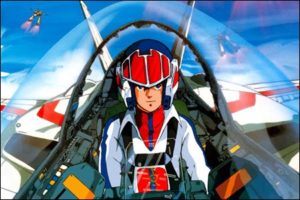In 1984 Carl Macek teamed with production company Harmony Gold to release the animated series Robotech. I was 8 years old and in love with anything that featured spaceships, lasers and explosions. Robotech was unlike anything I had seen previously. Voltron debuted around the same time and Transformers would appear a year later but there was something about Robotech that made it an essential part of my weekdays. I think what really captured my attention was that I had no idea what Protoculture was or why Zentraedi, the Robotech Masters or the Invid wanted it. Which put me in the same position of the human characters featured throughout the series. I’m not sure that I even understood that the Zentraedi, the Robotech Masters and the Invid were separate races (a space trinity of sorts). I certainly didn’t pick up on the fact that the series was made up of three unrelated Japanese series that had been spliced together to fill a year’s worth of programming. What I did know was that giant spaceships that could transform into giant robots were extremely cool.
Before sitting down with Robotech: The Complete Series I hadn’t watched the show in over 20 years and I was nervous that all the nostalgia in the world couldn’t save Robotech from being a convoluted mess. I most certainly didn’t intend on watching all 85 episodes along with the additional ten hours of bonus features. But, that’s exactly what I did. 17 discs and 40-something hours later I’m contemplating tracking down a copy of Robotech: The Shadow Chronicles to complete my journey.
The Robotech series begins with The Macross Saga, a 35-episode arc that tells the story of SDF-1, a giant alien spaceship that crashed on Macross Island a decade earlier, and the arrival of an alien race known as the Zentraedi that have come to take the fallen ship. Humanity, rallied together under the banner of the United Earth Government, attempts to fight off the invading forces while attempting to understand the secrets of the alien technology that the Zentraedi are devoted to recovering.
The Macross Saga is an undeniably brilliant story that somehow manages to comment on the emotional impact of war on the human spirit while also examining the importance of art and the role it plays in inspiring humanity through its darkest days. Pretty heady stuff for a children’s cartoon.
The second chapter, or war, in the Robotech series is the 24-episode arc known as The Masters Saga. The Robotech Masters, creators of the Zentraedi race, come to Earth in search of the mysterious Protoculture. Convinced that the approaching spaceships are signs of an impending full-scale invasion the United Earth Government strikes first setting up a war with the Robotech Masters that could spell the end of humanity.
For the first 10 or so episodes The Masters Saga is more of a soap opera than intellectually stimulating science fiction. It isn’t until the tone of the material shifts from romantic jealousy to the investigation of free will, the use of propaganda to justify conflict and the reoccurring impact of war on society that Robotech embraces what made it truly great in the first place.
The third war, 25 episodes known as The New Generation, finds Earth being occupied by an alien race known as the Invid. Having overwhelmed Earth’s forces following the conflict with the Robotech Masters the Invid have enslaved humanity. Tired of their captivity a small group of humans rally together to take on their Invid oppressors.
The New Generation is more even than The Masters Saga but it fails to capture the brilliance of The Macross Saga. It does however echo many of the themes from the previous series as it looks at the cost of war and the sacrifices that are necessary to ensure the freedom of humankind.
Included in the bonus features are extended cuts of various episodes along with 29 minutes that were used in Robotech: The Movie (which Carl Macek disowned) as well as a re-edited version of Robotech: The Sentinels, a series that was intended to extend The Macross Saga narrative but only three of the planned 65 episodes were completed. There are also numerous featurettes that range from international clips, video game adaptations and toy commercials. The set is highlighted by a newly created documentary Carl Macek’s Robotech Universe that tells the story of how Robotech came to be through interviews with the various voice actors and producers of the show. Unfortunately Carl Macek is not included due to his untimely death. There are also numerous still galleries that include pre-production art, character bios, comic book covers and merchandise.
It’s a shame that Macek wasn’t able to provide an audio commentary or contribute to the new documentary. Robotech was his vision and its hard to consider this box set complete without his participation.
Purists can continue to complain that Robotech is a bastardized version of the Japanese original series The Super Dimension Fortress Macross, Super Dimension Cavalry Southern Cross and Genesis Climber MOSPEADA but the history of anime in America would be quite different if it wasn’t for Robotech. Besides, their complaints seem rather hollow considering how good Robotech actually is. Put Robotech: The Complete Series on your Christmas lists because this box set is absolutely essential.
Or you could always just enter to win a copy here.
